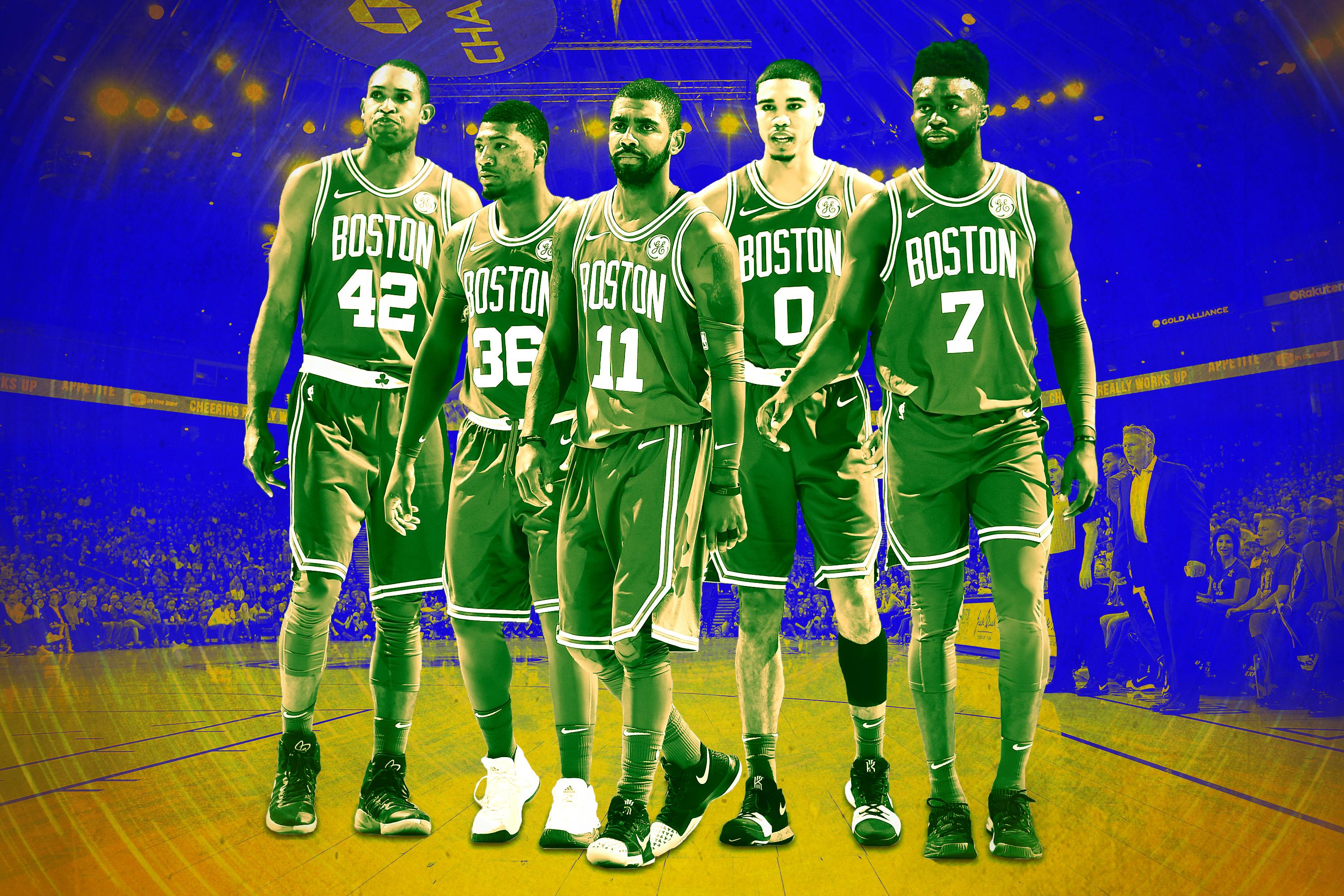Five Small-Ball Lineups That Could Challenge Golden State’s Dominance
The Celtics and Warriors are set to do battle in a game between the teams with the two best records in the NBA. Steph Curry and Co. have been steamrolling teams, but the Celtics could pose a serious threat with their not-so-secret weapon. Plus, four other potential Warriors-busting lineups that ought to be considered.
All roads to an NBA championship go through Golden State. After a surprising 4-3 start, the Warriors have been on cruise control and won their past seven games by an average of nearly 20 points. They have the best net rating (plus-14.4) and point differential (plus-11.9) in the league, and the second-best record (11-3). All they need to do through the next six months is avoid injuries. If they are healthy, they will be the overwhelming favorites to win their third title in four years. Every other contender has to operate on two separate tracks: They have to figure out what mix of players and style of play works for their team, as well as which of those lineups can best match up with Golden State.
Golden State’s trump card is the Lineup of Death, with Steph Curry, Klay Thompson, Andre Iguodala, Kevin Durant, and Draymond Green. That group had a net rating of plus-32.9 in 65 minutes in the playoffs last season. They are the glass box Steve Kerr breaks in case of emergency. The normal rules of lineup construction don’t apply to them. They spread five shooters out along the 3-point line without giving up anything on defense. It’s almost impossible to stay big against Golden State’s best players. Big men can’t guard Durant and Curry on the perimeter, and they can’t score on Durant and Green in the lane.
The Warriors are dragging the rest of the NBA into a new era of basketball. The only way to match up with the Lineup of Death is to beat them at their own game, and use lineups with five players who can play on the perimeter on offense and defense. Combinations that would have been unimaginable a generation ago have to be tried against Golden State. There’s no reason to play it safe. If you are going to lose anyway, you might as well go down swinging.
With that in mind, here’s a look at five small-ball lineups that might have a chance against the Warriors.
Celtics: Kyrie Irving, Marcus Smart, Jayson Tatum, Jaylen Brown, Al Horford
Minutes played: 48
The Celtics face the Warriors for the first time Thursday night in what could be a Finals preview. Boston has been one of the best stories in the NBA in the first month of the season. No one thought it would be this good without Gordon Hayward. When its prized free-agent acquisition went down with a horrific leg injury on opening night, the season seemed over. Instead, after losing their first two games without Hayward, the Celtics have reeled off 13 consecutive wins. They have the best record in the league, thanks mainly to their no. 1-rated defense.
Boston doesn’t have to adjust much to match up with Golden State. Brad Stevens starts two big men in Al Horford and Aron Baynes, but he usually closes games with Horford and four perimeter players around him. If any center can stay on the floor against the Warriors, it’s Horford. He is an excellent 3-point shooter (48.8 percent on 3.2 attempts per game this season) and a capable playmaker in the high post (4.5 assists per game), and he’s quick enough to slide his feet on the perimeter and stay in front of smaller players.
Horford and Kyrie have already become a dynamic pick-and-roll combination. They present many of the same challenges as Steph and Draymond on the play. Kyrie and Horford can both stretch the floor and score on switches, and Horford can make the correct read on a four-on-three if the defense tries to trap Kyrie and take the ball out of his hands. Something is almost always open when the two work in tandem, and the Celtics put enough 3-point shooting around the pair to punish the defense if they send extra help.
Kyrie has shown he can score consistently on the Warriors in the biggest moments. He averaged 27.1 points a game on 46.8 percent shooting against them in the 2016 Finals, and 29.4 points a game on 47.2 percent shooting in the 2017 Finals. He’s one of the most unstoppable one-on-one scorers in the NBA, and even elite perimeter defenders can’t do much more than put a hand in his face and hope he misses. If the Celtics can prevent the Warriors from pulling away in the first 46 minutes, Kyrie will give them a puncher’s chance late.
Boston has the personnel to make Golden State work on offense. Smart and Brown are two of the best perimeter defenders in the NBA, and Tatum has been surprisingly advanced for a rookie. The question is whether Kyrie and Horford can hold up. Kyrie is playing better defense this season, but he’s an undersized player who has been inconsistent defensively his whole career. Even a big man as quick as Horford will struggle to contain Durant and Curry in space. Boston might need one more versatile forward to plug holes on defense. And who knows? Maybe Hayward can come back in the playoffs and make things interesting.
Rockets: Chris Paul, James Harden, Trevor Ariza, P.J. Tucker, Luc Mbah a Moute
Minutes played: Zero
The Paul trade dominated most of the offseason headlines in Houston, but signing Mbah a Moute and Tucker as high-level backups was just as important when it comes to the Rockets’ ability to match up with Golden State. Houston’s starting frontcourt can’t keep up with the Warriors. Ryan Anderson has no chance of guarding them, and Clint Capela isn’t much of a perimeter threat on offense. And while Capela is fairly quick for a center, it’s still hard for him to switch screens and chase shooters around the 3-point line. Mbah a Moute and Tucker let the Rockets go small.
The trio of Ariza, Mbah a Moute, and Tucker would give Houston as much length and athleticism on the wings as any team in the league. Ariza is an elite 3-and-D player who can slide among three positions, while Mbah a Moute (6-foot-8 and 230 pounds) and Tucker (6-foot-6 and 245 pounds) are versatile defenders in their own right. They are built like tanks, but they have the quickness to guard smaller players. Just as important, they are both knocking down enough 3s this season that the Warriors can’t ignore them on offense.
The key to Houston’s dramatic 122-121 win against Golden State on opening night was its newfound defensive trio. The Rockets closed the game with those three up front and Harden and Eric Gordon in the backcourt. Other than Paul sitting late, it was exactly how Daryl Morey and Mike D’Antoni drew it up in the offseason. The Rockets spread the floor for Harden and Gordon, who combined for 51 points on 39 shots, held the Warriors to a near draw at the 3-point line, and played just enough defense to win.
Paul has missed every game since with a knee injury, and his absence has solidified Harden’s control of the team. He will have to figure out how to play off the ball next to Harden, a role in which Gordon has thrived. Gordon was awesome against Golden State, and it won’t be easy for D’Antoni to take him off the floor in crunch time. He is attempting 10.9 3s per game this season, and his size (6-foot-4 and 215 pounds with a 6-foot-9 wingspan) gives him more defensive versatility than Paul.
D’Antoni could play all three of his perimeter stars at the same time, but that would mean taking out one of his defensive stoppers. He will have to make a trade-off between offense and defense no matter what he does. Playing Harden, Paul, and Gordon together would make Houston undersized on the perimeter, but playing three limited offensive players like Mbah a Moute, Tucker, and Ariza would put a lot of pressure on the other two guys in the lineup. Houston, like everyone else, doesn’t have as many elite two-way players as Golden State.
Cavs: Iman Shumpert, J.R. Smith, Jae Crowder, Jeff Green, LeBron James
Minutes played: 10
Cleveland has been a disaster this season. It needed a dramatic comeback against the Knicks on Monday just to make it back to .500, and it has the worst defense in the league. The Cavs have made a habit of coasting through the regular season only to turn it on in the playoffs, but this is the weakest they have looked in LeBron’s second stint with the franchise. Kyrie Irving is gone, no one knows when Isaiah Thomas will come back or what he will look like, and the lack of rim protection is dragging the whole team down.
However, necessity is the mother of invention, and Tyronn Lue may have stumbled onto something during a furious comeback against Houston last week. With Tristan Thompson out, Lue benched Kevin Love and Channing Frye and went five-out with LeBron and Jeff Green in the frontcourt next to three perimeter players who are all at least 6-foot-5. That group had a net rating of plus-26 in nine minutes against the Rockets, and it’s exactly the type of lineup Cleveland will need if it wants to have any chance of knocking off Golden State.
LeBron was essentially playing as the point guard on offense and the center on defense, which takes away the two positions on the floor that the Warriors usually attack in the pick-and-roll. Love (minus-13.6) and Thompson (minus-11.3) had the two worst net ratings on Cleveland’s roster in last year’s Finals. They weren’t able to do nearly enough on offense to make up for what they gave up on defense. Thompson held his own in the 2016 Finals, but that was when Curry was essentially playing on one knee. It was also before the arrival of Durant, who is a mismatch for every big man in the league.
The problem with using this lineup against Golden State is that it asks a lot from Green, a famously inconsistent player who has teased coaches with his talent his entire career. He looked incredible against Houston, scoring 27 points on 15 shots and even staying in front of Harden on switches. Green is thriving next to LeBron: He’s shooting a career-high 49.5 percent from the field, and he’s tied for the second-best net rating (plus-2.6) of anyone in the rotation. He would give Lue a lot of options if he can maintain this level of play going forward.
Even if he doesn’t, though, Cleveland can mix and match a lot of different players around LeBron when he plays point center. Thomas, Dwyane Wade, and Derrick Rose could all provide a secondary scoring punch, though Thomas is the only one who can shoot and all three might be catastrophic on defense. Wade has not played well through the first month of the season, but he’s presumably saving whatever he has left for the playoffs. If he can turn back the clock somewhat and take some pressure off LeBron, the Cavs will still be dangerous.
Thunder: Russell Westbrook, Paul George, Andre Roberson, Carmelo Anthony, Jerami Grant
Minutes played: 6
Oklahoma City has started as slowly as Cleveland, and it doesn’t have injuries or old age as an excuse. Carmelo is the only Thunder starter on the wrong side of 30, as well as their only key player who has missed any time this season. Nevertheless, there was always going to be an adjustment period to integrate so many new faces into the mix, and the Thunder have the talent to be a threat if they can get on the same page. The focus is on their new Big Three, but their defense is what makes them an intriguing matchup for Golden State.
The Thunder have the no. 2-rated defense in the NBA, and they cover a ton of ground in the half court. They start two perimeter stoppers with elite length and athleticism in George and Roberson and bring another off the bench in Grant. Westbrook isn’t known for his defense, but he’s one of the biggest and fastest players at his position in the league, as is Adams. The key for Billy Donovan is finding a way to keep his defensive personnel in while spreading the floor on offense.
Roberson is a walking trade-off. He’s their best defender, but he can’t shoot to save his life and no one guards him when he’s anywhere outside of the paint. Donovan made Golden State account for him in the 2016 Western Conference finals by using him as a roll man and a screener, which means putting four 3-point shooters around him. George and Carmelo are both shooting at least 40 percent on catch-and-shoot 3s, and Westbrook is shooting a career-high 34.4 percent overall from 3 this season. The fifth spot in the lineup is the question mark for Oklahoma City.
Grant was acquired from Philadelphia last season, and he could be the answer. At 6-foot-9 and 220 pounds with a 7-foot-3 wingspan, he can protect the rim and guard players at all five positions. At 23, he’s already much further along than Roberson, and he has the ability to attack defenders off the dribble and get to the rim. Grant is 50-for-140 from 3 (35.7 percent) in two seasons with the Thunder. If Oklahoma City can develop him into a stretch 5 who switches screens by the time the playoffs roll around, the rest of the pieces will fall into place.
Much like Houston, Oklahoma City can put out a lineup with three versatile defenders around two perimeter stars. The difference is that it wouldn’t have to make the same trade-off between offense and defense with the fifth spot because George can do both at a high level. The Thunder would still be counting on Westbrook and Carmelo to play a more disciplined brand of basketball than they are known for, but both of their reputations are on the line this season. They have every incentive to be on their best behavior and make this work.
Bucks: Eric Bledsoe, Malcolm Brogdon, Tony Snell, Khris Middleton, Giannis Antetokounmpo
Minutes played: 0
Trading for Bledsoe has given the Bucks a needed shot in the arm. They are 3-0 since making the deal for the disgruntled point guard, including wins against San Antonio and Memphis. Bledsoe hasn’t shot the ball well, but his ability to attack the lane takes pressure off the rest of their supporting cast, and he gives the Bucks another long and athletic defender who is at least capable of executing Jason Kidd’s scheme. They have a net rating of plus-9.6 with him on the floor.
Bledsoe’s arrival has made Brogdon a sixth man, easing Milwaukee’s bench woes in the process, but the two point guards should be able to play together in crunch time. Brogdon has the size (6-foot-5 and 215 pounds with a 6-foot-10 wingspan) to slide among multiple positions on defense, which is a similar trait among all of Milwaukee’s best players. Snell and Middleton are supersized wings who can play in the frontcourt, and Giannis has the physical tools to guard just about every player in the NBA.
Jason Kidd hasn’t played Giannis much as a small-ball 5, and there’s no reason to put him through the punishment that comes with playing the position in the regular season. However, in the playoffs, moving Giannis to a point/center role would unlock some fascinating lineups for Milwaukee and allow the Bucks to play their five best players at the same time. He has the size and skill set to pull it off. Giannis is 6-foot-11 and 222 pounds with a 7-foot-3 wingspan, and he’s averaging 10.3 rebounds and 1.8 blocks a game this season.
The Bucks still need to figure out how Jabari Parker fits into their lineup when he returns from his second ACL tear at some point around the All-Star break. Playing Giannis at the 5 would allow them to play Parker without compromising their 3-point shooting and defense too much. Brogdon, Snell, and Middleton are all elite shooters who can space the floor for Giannis and either Bledsoe or Jabari. Kidd will have a lot of options, if he chooses to use them. A fully weaponized version of the Milwaukee roster would be scary for anyone to face.

